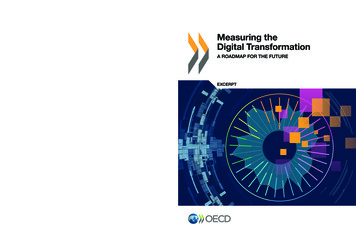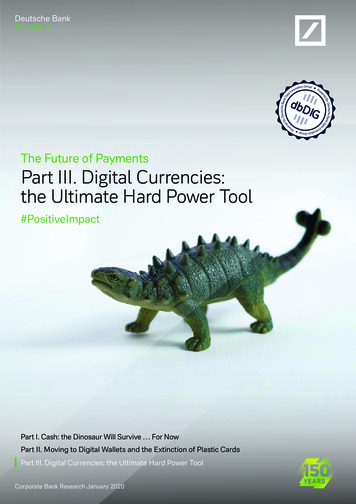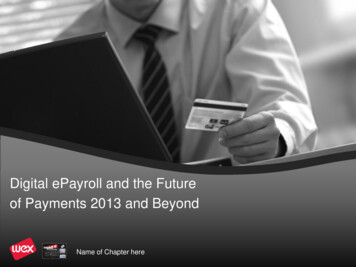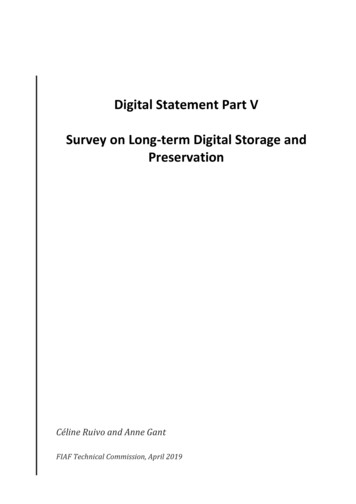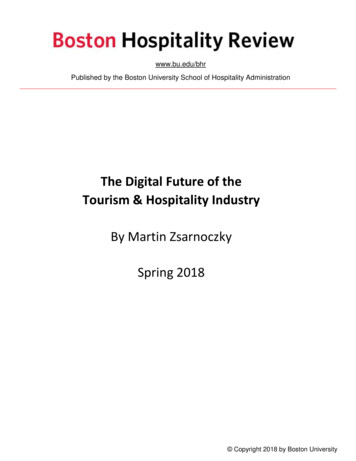
Transcription
www.bu.edu/bhrPublished by the Boston University School of Hospitality AdministrationThe Digital Future of theTourism & Hospitality IndustryBy Martin ZsarnoczkySpring 2018 Copyright 2018 by Boston University
By Martin ZsarnoczkyDigitalization is among the most important changes in our rapidly evolving world.Digital innovations and technological novelties are engines of development and showtheir impact everywhere, especially in the field of manufacturing, ICT and other serviceindustries. Given the fact that tourism is based on the cooperation between a wide rangeof services and products, the benefits of the digital revolution in the sector are quiteobvious.Our living environment is a combination of online and offline spaces that co-existtogether, defining our everyday habitat. In tourism, the special use of spaces has alwaysbeen a unique feature of the industry, and as of today, the spaces of the digital worldhave become part of it. The rapid development of the digital world brings novel andinnovative solutions into the digital tourism spaces by the day. Peer-to-peercommunication is outstandingly important in the technological environment of tourism.This type of communication, together with the spreading of smart devices haverevolutionized scheduling, administration and finances, and also opened new horizonsfor the introduction of innovative sales and marketing technologies in the whole tourismindustry. As a result of the digital revolution, the international development trends intourism have opened the way for novel solutions like cloud-based booking sites orinformation and experience sharing via digital platforms.In line with the new trends of travelling, there is a dynamically growing demand forspecial tailor-made offers beyond mass tourism, as conscious consumers expectpersonalized solutions that answer their individual needs. As of today, the vast majorityof tourism market stakeholders have access to detailed information on their consumerspg. 1
and can closely follow and track consumer behavior and its changes. These novelsystems of personalized products and services are available thanks to various flexiblefollow-up techniques like CRM client databases. The cloud-based CRM client databasesystems – ones that create offers by analyzing previous sales records and demographicdata – have evolved rapidly. As of today, they can analyze huge datasets by big dataanalysis and scaling methods in a cost effective and anonymous way, searching forsignificant event points. Although big data research is based on working with largesamples, it is the most efficient method to reveal individual personal preferences(Stadler, 2015).How did sharing economy pave the way to personalized tourismservices?In previous decades, the results of digital development have opened the door for the reallife implementation of shared economy theories. It was almost ten years ago that ChrisAnderson (2009) introduced his pricing theory in digitalization, basically suggestinggiving away products for free, based on the principle of shared goods and resources.Although at the time Anderson’s theory was considered as a technological solution, theprinciple of digital sharing have induced serious social changes as well. One of the mostimportant positive messages of shared economy is the maximum use of resourcecapacities for the purpose of social well-being (Sundararajan, 2014). Social well-being isalso a key priority in tourism, because a well-managed tourism industry brings profitnot only for the business operators but also for the local communities.In the sharing economy model, the stakeholders – who are also consumers at the sametime – offer their excess capacities for collective use in order to maximize theexploitation of their goods and resources. These economic processes consist of so-calledhybrid transactions with maximum capacity use (Hyde, 2007), for both commercial andsocial purposes. An important drive in the evolution of collaborative consumptiontheory was the realization of the fact that using or possessing the same consumer goodscan result in different advantages. The core element of the model is that sellers offertheir excess capacities, while the consumers in need use them in return for payment. Inthe sharing economy (based on the aforementioned primary idea), more and moreindustrial, commercial and service providers offer innovative solutions.The principle of sharing is not a new idea in the tourism industry. In the case of someaccommodation services, seasonal price reduction has always been a practice. Hostelsand youth hotels have always been popular – these facilities are often used asdormitories throughout the academic year and lease their rooms for backpackers in thesummer season, when the students are away. Of course, these seasonal options wouldnot have been enough for creating a new market sector; the dawn of the new businessera was marked with the emergence of wide platform solutions like Airbnb,Booking.com, Agoda, etc.pg. 2
Casa de la Musica Hostel Budapest. Photo by Martin ZsarnoczkyIn the strategy of digital platform tourism businesses, consumers are considered aspartners in the business activities. This shared operation can be best defined as apostmodern business model. Although the complex idea of postmodernism is quitedifficult to describe, its main characteristics – shared participation and the subjectivepassion of each contributor – can lead closer to understand the phenomenon. It is clearthat postmodernism will change some processes of the classic market laws in the nearfuture. While "shared experience" has become a key marketing term for selling goodsand services, specialized offers inevitably lead to a market fragmentation that will resultin the fragmentation of users as well. In a disintegrated market, consumers will behavedifferently in fragmented times and spaces, paving the way for personalized services andtailor-made solutions. At the same time, individualism has become the keycharacteristics of the younger generations (McCrindle et al., 2009); a phenomenon thatwill have to be taken into account whilst creating business strategies. Due to theemergence of individualism, more and more young people are trying to createsomething unique that can serve the long-term benefit of the community. Their drive forcreating businesses based on their own ideas and experience accounts for the increasingpopularity of start-up businesses. These aspects of uniqueness, community thinking andexperience-centered approach hold a huge opportunity for the future of the tourismindustry.The Future: AI, VR/AR, BlockchainWhile looking through their photos, tourists usually have a positive experienceremembering their travels, experiences and the destination they had visited. Somepg. 3
specialized digital technologies can offer this assumed positive experience in asearchable and changeable form. With regards to real life objects, their connections andrelations, there is only a limited amount of information available in a format that couldbe handled by computers. The main problem is that computers need sufficient codingsolutions created by artificial intelligence to be able to store, handle and organizeinformation. The methods of coding for tourism experience purposes affect the speed,efficiency and knowledge/experience-based computing abilities of today’s computers.According to the forecasts of product development strategies in various industries,almost all of our everyday objects and equipment will be accessible through the internetin the future. As a result, all devices that are capable of two-way communication willbelong in the framework of IoT (Internet of Things). The devices of the future, unlike thedevices of today, will communicate in a bidirectional way, where robust safe datahandling, personalized differentiation and sufficient decision management will be partof the user experience. As a result of the continuous data collection during the use ofthese devices, all relevant information will eventually end up in a final centralizedsystem at the top of the dataset.Previously, tourism used to be an industry based on personal relations and connections,where the trends - and therefore travelers’ decisions - were set out by a limited numberof large international tourism and travel enterprises. As a result of the digital revolution,the transparency of "hidden markets" had been revealed and numerous other factorshave to be taken into account (Fig.1.).Figure 1. Influencing factors of traveler’s decision. Source: Zsarnoczky, (2017a)The early development of ICT resulted not only in the better capacity utilization ofairlines, but also on the compatibility of the prices; and soon, the emergence of thepg. 4
discount airlines had led to the innovation of the whole industry and forced outefficiency in all segments. The novel travel recommendation sites (Expedia, Orbitz,Kayak, etc.) were created with the aim to make travelers’ decisions easier; however atthe same time, a lot of tourism service providers who could not keep up with the newchallenges were forced out of the market. Although the new trends like travel packages(including car rental) or taking into account the reviews of previous travelers (LonelyPlanet) were from many aspects opposite to the former business models, the rapidlyincreasing popularity of online offers required quick and user-friendly tourism productdevelopment from the industry.With the arrival of Google, which was able to rank the sites’ appearance in internetsearches, a fierce competition begun between blogs, tourism recommendation sites andprice-comparing OTA systems. The bidirectional communication started with the use ofcookies 2.0; since then, consumers have become an integral part of the business models,because businesses who seek to be successful in the long run, need to know theircustomers’ demands in detail. The development of digital services require theidentification of the user, information on their individual preferences and a decisionbased calibration (by AI). In AI-based decision making solutions, the former decisivefactors are replaced by a virtual personal assistant, which is able to map the consumer’spreferences based on their digital footprint, and create an optimal personalized offerfrom the available big data systems (Fig. 2.)Figure 2. Virtual Personal Assistant – VPA. Source: Zsarnoczky, (2017a)pg. 5
The technological development cannot be stopped; however, with sufficient flexibilityand openness, tourism businesses can prepare for the upcoming challenges. In thetourism of the future, the new consumers will bring forth new priorities and newdemands. As a revolutionary approach, the members of the IoP (Internet of People)community offer their free time in order to reach joint IT/industrial goals, whereframeworks are created in line with the preferences of other people, for a yet notspecified consumer segment (Miranda et al., 2015). Beyond innovative technologies,whole new spaces have opened in tourism, completely different from the usualdestinations. University researchers[1] have been carried out to study the possibilities ofonline tourism spaces and their opportunities for the tourism and hospitality industry.In virtual reality, with a special "glass", the user can look into an optional tourism space,from which the real world is completely shut out. The Augmented reality is a differenttechnological solution, where digital elements are projected into a real life space.In 2011, the interior designers of cafés only used and re-designed the existing designpanels; today, the traditional living spaces are often combined with the online world.Carneval Coffee Budapest. Photo by Martin ZsarnoczkyThe newest technological developments and the innovation in the use of living spacesare all connected to the alternative payment options that can be used in tourism as well.The emergence of Bitcoin and other cryptocurrencies has led to the creation of a novelpayment system. The Blockchain payment system is a shared database, which records acontinuously growing list of data blocks, preventing any counterfeiting or alteration ofthe data. One block consist of a list of transactions and the results of computations madeby the stored programs. For example, if a customer buys some cryptocurrency or anyother kind of currency, and then transfers it to anywhere in the world to anotherpartner, who exchanges it instantly, both partners can avoid any loss caused bypg. 6
exchange rate fluctuations; furthermore, the whole transaction takes only minutesinstead of the usual couple of business days. This solution can mean a revolutionaryinnovative payment option for everyone in the tourism industry.The applicability of the blockchain system is independent from currency rates. In thecase of cryptocurrencies, it is not the exchange rate that really matters - instead, the truevalue of the currency lies in the safety of the blockchain technology and in the authentic,transparent, unalterable and decentralized recording system (Pilkington, 2016). Thispayment system offers a new level of encryption safety and intervention-free operation,and the data handled in the system cannot be modified in any way. Another huge benefitof the system is that the transactions are realized without any intermediate agents, thuseliminating any additional transaction costs. By the time of the "maturity" of blockchainpayment solutions, today’s large service intermediators like Airbnb, Booking.com,Agora, etc. are foreseen to lose some of their market positions, as consumers and serviceproviders will probably deal with their transactions directly.Will Artificial Food be the next meal on the table?With the worldwide population boom, the demand for food is also increasing. To satisfythis growing need for food, the extension of agricultural areas is required for foodmaterial production, and at the same time, sufficient land management is needed foranimal husban
factors are replaced by a virtual personal assistant, which is able to map the consumer’s preferences based on their digital footprint, and create an optimal personalized offer from the available big data systems (Fig. 2.) Figure 2. Virtual Personal Assistant – VPA. Source: Zsarnoczky, (2017a)



